Introduction
Background
Objectives and Methods
Results
Recommendations
Introduction
In December 2013 the Māori community of Ngāti Kea Ngāti Tuara (NKNT) in Horohoro, New Zealand installed a series of three micro-hydroelectric turbines to power their hapū (village). The turbines utilize the potential energy of a waterfall in the nearby Pokaitu stream to produce clean, sustainable energy. The system currently produces more electricity than the community needs and the hapū sells the surplus electricity back to the grid for an insignificant profit. Our project sponsor, Dr. Maria Bargh, is a member of the hapū and a professor at the School of Māori Studies at Victoria University of Wellington. With her guidance and assistance, the team developed a feasibility plan for a greenhouse that provides the members of the Ngāti Kea Ngāti Tuara Hapū with an effective strategy to utilize the available electricity produced by the community’s micro-hydro power system. The project also investigated a solution for the turbine intake congestion problem present in the micro-hydro unit.
Back to Top
Background
The Ngāti Kea Ngāti Tuara Hapū is located in a rural town called Horohoro (starred in Figure 1), which is situated approximately sixteen kilometers south of Rotorua, the economic center of the Bay of Plenty region (highlighted in green in Figure 1).
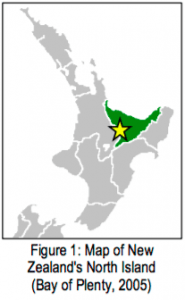 NKNT’s micro-hydro facility powers the community’s Marae (meeting house), church, a nearby farm, a Māori language immersion play-center and the Horohoro Primary School. The hapū’s values, outlined in the community’s strategic development plan, guided our methodologies and heavily influenced our decision-making. The plan emphasizes that any endeavor must satisfy certain economic, environmental, social, and cultural standards. Our greenhouse proposal fulfills these standards, often referred to as the hapū’s quadruple bottom line. The actions of the community must not only yield a profit, but more importantly benefit the environment, unite the members of the hapū, and align with their guiding cultural values.
NKNT’s micro-hydro facility powers the community’s Marae (meeting house), church, a nearby farm, a Māori language immersion play-center and the Horohoro Primary School. The hapū’s values, outlined in the community’s strategic development plan, guided our methodologies and heavily influenced our decision-making. The plan emphasizes that any endeavor must satisfy certain economic, environmental, social, and cultural standards. Our greenhouse proposal fulfills these standards, often referred to as the hapū’s quadruple bottom line. The actions of the community must not only yield a profit, but more importantly benefit the environment, unite the members of the hapū, and align with their guiding cultural values.
Hapū member Kataraina George weighed the viability of a few potential crops and livestock in an initial feasibility report from 2014 – The Feasibility of Tuna/Koura/Watercress Cultivation. The next step in the process, and where our project began, was to determine the feasibility of a greenhouse and to recommend specific crops that would do well in this setting. Of the options presented by Ms. George and those gathered from our own research, we determined that both watercress (a leafy super- food) and koura (freshwater crayfish), displayed in Figure 2, had the biggest potential to meet the community’s needs as well as the desires of the surrounding market. We considered hydroponic (grown in nutrient-enriched water without the use of soil) and aquaponic (a symbiotic relationship between plants and fish) growing options as technology the hapū could use in the greenhouse.
had the biggest potential to meet the community’s needs as well as the desires of the surrounding market. We considered hydroponic (grown in nutrient-enriched water without the use of soil) and aquaponic (a symbiotic relationship between plants and fish) growing options as technology the hapū could use in the greenhouse.
The local market, particularly in Rotorua, presents the opportunity for the hapū to commercially sell the crops and livestock they produce to a number of upscale restaurants in a section of town playfully named “Eat Streat”, as well as a nearby luxury resort, Treetops Lodge, located just down the road from the hapū in Horohoro. While turning the greenhouse into a commercial venture is not the community’s number one goal, it is important to the hapū that the project be economically sustainable.
Currently the micro-hydro system suffers from intake congestion caused by pine needles and other debris. A worker must manually clear the debris that accumulates on a daily basis to ensure the turbines are operating to their fullest potential. Since the greenhouse would need to utilize electricity from this system, it is important that the turbines be running smoothly. With this information in mind, the team developed five objectives that we have completed throughout this project.
Back to Top
Objectives and Methods
The objectives for the project were as follows:
- Assess the opinions of relevant stakeholders.
- Research and recommend crops to grow in the greenhouse.
- Propose a growing system and physical parameters for a greenhouse.
- Document care and maintenance methods for NKNT’s hydroelectric turbines.
- Suggest a strategy to alleviate turbine intake congestion.
The team was able to collect a combination of qualitative and quantitative data through interviews, surveys, participant observation, and literature reviews. Our first and second objectives used similar methodologies and are closely related, as the second objective depends on the results we gathered form our first goal. We defined our stakeholders and chose potential crops of interest through our initial research conducted prior to our departure while in Worcester, Massachusetts. Shortly after arriving in New Zealand, the team took a trip up to Rotorua, where we conducted semi-structured interviews with hapū members and Eat Streat restaurants, as seen in Figure 3. 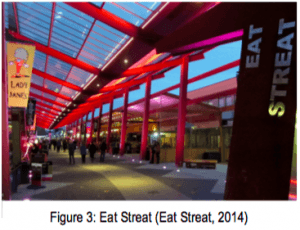 The team took only one trip to Horohoro to gather most of this information, thus the success of this project depended on careful preparation and planning in the weeks leading up to the trip. While on site, two team members conducted each interview and recorded conversations both digitally and through written notes. The team then transcribed these conversations for later reference when developing recommendations and making decisions. The team also conducted 42 short, three-minute surveys with those walking through the Eat Streat area. These surveys provided not only demographic information, but also opinions on watercress and koura and knowledge of Māori cuisine. This data provided a quantitative view of local consumer perspectives. Since the team was only able to conduct two formal interviews with hapū members, we created a survey on Google Forms. Dr. Bargh posted this supplementary survey on the hapū’s Facebook group to gather opinions from a greater pool of hapū members.
The team took only one trip to Horohoro to gather most of this information, thus the success of this project depended on careful preparation and planning in the weeks leading up to the trip. While on site, two team members conducted each interview and recorded conversations both digitally and through written notes. The team then transcribed these conversations for later reference when developing recommendations and making decisions. The team also conducted 42 short, three-minute surveys with those walking through the Eat Streat area. These surveys provided not only demographic information, but also opinions on watercress and koura and knowledge of Māori cuisine. This data provided a quantitative view of local consumer perspectives. Since the team was only able to conduct two formal interviews with hapū members, we created a survey on Google Forms. Dr. Bargh posted this supplementary survey on the hapū’s Facebook group to gather opinions from a greater pool of hapū members.
We accomplished our third objective, actually considering the physical parameters and technologies surrounding a greenhouse, through an interview with PlentyFlora, a glasshouse specializing in flower horticulture, and through reviews of technical literature. Our initial plan to grow watercress and koura meant thorough research into many broad design parameters: water supply, irrigation, nutrients and nutrient distribution, and growing apparatuses. The hapū will ultimately decide the structure of the greenhouse based on information we have provided in a flow chart. Our recommendations section further expands on this idea.
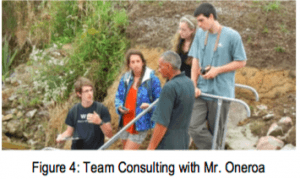 We developed our fourth and fifth objectives to provide the hapū with documentation of regular maintenance of the micro-hydro system and investigate solutions to the turbine intake congestion problem. Dr. Bargh encouraged us to create a maintenance manual for the turbines in the case that Mr. Riki Oneroa, who currently maintains the system himself, is unavailable to care for the unit. The team accomplished both of these objectives through research of other turbines with debris problems and through participant observation with Mr. Oneroa (Figure 4), who gave our team a thorough tour of the micro-hydro unit. During this tour we recorded our conversation with Mr. Oneroa as he answered our questions regarding congestion and maintenance. We also took pictures of the turbines and surrounding area to reference in the manual and our report.
We developed our fourth and fifth objectives to provide the hapū with documentation of regular maintenance of the micro-hydro system and investigate solutions to the turbine intake congestion problem. Dr. Bargh encouraged us to create a maintenance manual for the turbines in the case that Mr. Riki Oneroa, who currently maintains the system himself, is unavailable to care for the unit. The team accomplished both of these objectives through research of other turbines with debris problems and through participant observation with Mr. Oneroa (Figure 4), who gave our team a thorough tour of the micro-hydro unit. During this tour we recorded our conversation with Mr. Oneroa as he answered our questions regarding congestion and maintenance. We also took pictures of the turbines and surrounding area to reference in the manual and our report.
Back to Top
Results
The hapū survey received 16 responses. The answers displayed general widespread approval of both the greenhouse as well as the candidate crops. Of the 15 respondents, 14 felt a greenhouse would benefit the community. When asked exactly how a greenhouse might benefit the community, the most popular answers included job creation, a source of food, and increasing the hapū’s commitment to sustainability. Each choice received 13 votes. The responses also included short recommendations and reactions, such as from one hapū member who thought that it “would be great to see the hapū getting involved with sustainability processes rather than cultivation for commercial benefit”.
Although these responses were very useful, they lacked an in-depth specificity in exchange for a larger sample pool. Our semi-structured hapū interviews provided a depth which paired nicely with the hapū survey. Of the two community members we interviewed, we found similar patterns as in the survey. The team found the responses that deepened our understanding of why a greenhouse fits in with Māori culture particularly useful. One interviewee explained that Māori “believe in life, we believe in nurturing a seed to full growth. The whole cycle” (Keepa, 2016). These two sets of results together allowed the team to target the recommendations more specifically to the hapū’s culture and needs.
In order to allow the hapū to commercialize their greenhouse products, should they desire to do so, the team measured the market through restaurant interviews and customer surveys. Understanding restaurants’ needs gave the hapū specific potential business partners, and surveying customers in Rotorua provided the hapū tools to approach other restaurants with market data.
Primarily, the market data assessed responses to candidate crops and responses to potential marketing angles for greenhouse products, which included the crop being organic, locally sourced, Māori-grown, and produced with clean energy. The team found that all four of these labels drew positive responses. Figure 5 details the average response to the selected labels (n=41).
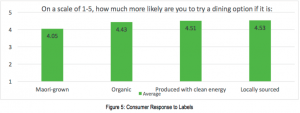
The surveys also collected data about customers’ responses to the team’s candidate crops (Figure 6). Out of the 41 respondents, 32 had eaten watercress previously. Of those 32, 29 would be willing to try it again. Similarly, 25 had eaten koura previously, and 22 of those would be willing to try it again.
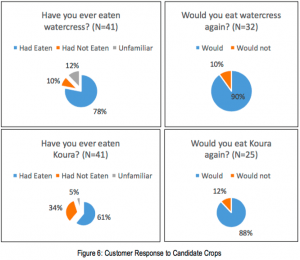
These results were promising, because they indicate an already existing market for the team’s candidate crops. In a similar vein, the team interviewed representatives from restaurants in the Eat Streat area in Rotorua as well as the luxurious Treetops Lodge right in Horohoro. Of the six establishments interviewed, four expressed interest in potentially buying one of the candidate crops from a Ngāti Kea Ngāti Tuara greenhouse. This set of data suggests that both restaurants and customers in the Rotorua area are interested in the candidate crops.
With a positive reaction for a greenhouse from the community and surrounding businesses promising market potential for the candidate crops, the team conducted further research through technical literature reviews and utilized the information gained in the PlentyFlora interview. The interview yielded information regarding the geothermal heat source used within their greenhouse and their varying successes and failures. This interview also answered our questions regarding potential problems surrounding the greenhouse structure and weather conditions specific to the region. Further research into greenhouse structure revealed the biggest constraint is water supply, which must be approved by a resource consent from the Waikato Regional Council. The resource consent process may take years, but NKNT is patient as their goals are long-term. Although this constraint prevented the team from recommending exact specifications for a greenhouse, literature review indicated a general system for growing – one large water recycle circuit, pressurized with a pump powered by the turbine’s power output.
The team converted our interaction with Mr. Oneroa into a comprehensive maintenance manual, so the community can be further involved in care of the micro-hydro system. The hapū’s request for a solution to the turbine intake congestion resulted in review of technical literature. The following section outlines this recommendation.
Back to Top
Recommendations
The team chose to present its discoveries in a manner that would allow the hapū to take our findings and 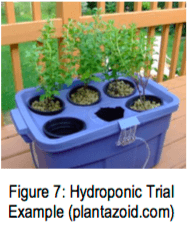 choose for themselves which option they would like to explore. We constructed a series of
choose for themselves which option they would like to explore. We constructed a series of
flowcharts to guide their decision-making regarding greenhouse size, crop selection, and purpose. Therefore, the team did not select one specific greenhouse configuration, but rather presented a series of recommendations contingent on the community’s desires. In brief, however, the team believes that an aquaponic greenhouse can accommodate the requests of the community, whether it be for job creation, education, or commercial benefit. Additionally, the team recommends that the hapū first perform hydroponic growing trials, such as the one seen in Figure 7, to grow crops cheaply and check the taste and quality of product before committing to a larger structure.
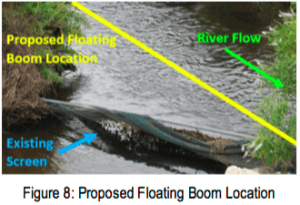 Regarding the problem of habitual congestion of the micro- hydro’s intake, the team recommended that NKNT implement a floating boom device in conjunction with the existing screen. The boom, as Figure 8 shows, would stretch from further upstream to just beyond the intake inlet, almost parallel to the flow of the river. This mechanism would direct floating debris downstream without requiring cleaning. As a secondary measure, the existing screen would require much less regular maintenance, but would still offer protection against any non-floating debris and, most importantly, from fish and other wildlife entering the system.
Regarding the problem of habitual congestion of the micro- hydro’s intake, the team recommended that NKNT implement a floating boom device in conjunction with the existing screen. The boom, as Figure 8 shows, would stretch from further upstream to just beyond the intake inlet, almost parallel to the flow of the river. This mechanism would direct floating debris downstream without requiring cleaning. As a secondary measure, the existing screen would require much less regular maintenance, but would still offer protection against any non-floating debris and, most importantly, from fish and other wildlife entering the system.


